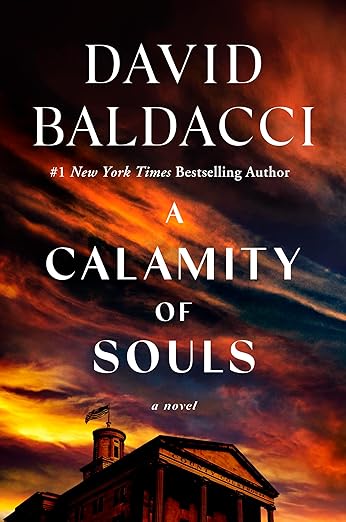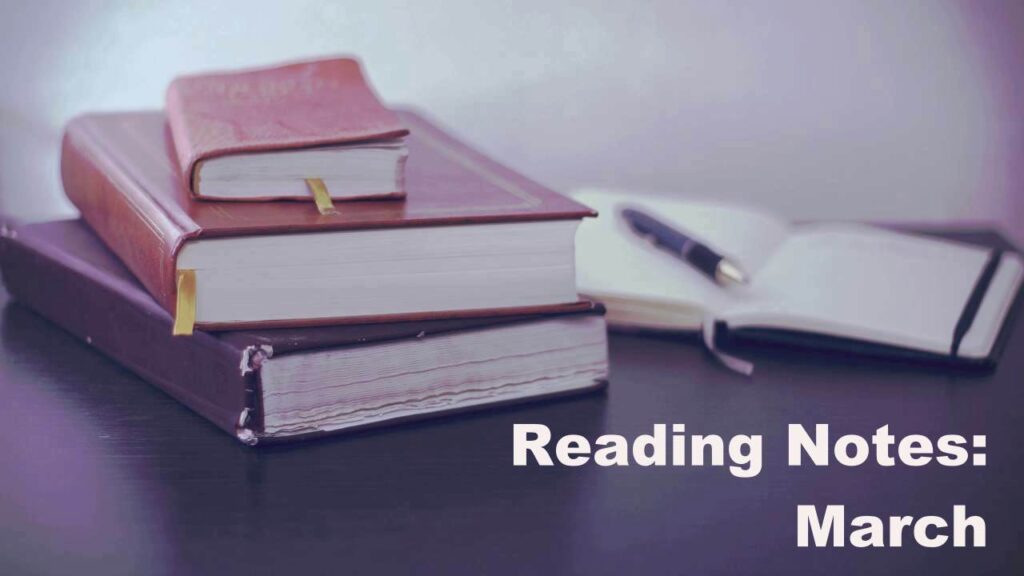My reading intentions for March were interrupted by the sudden death of my cousin in New Hampshire, an event that hit me more heavily than I thought it would. Waiting to hear about funeral arrangements and then the actual traveling knocked me out of commission for about two weeks. I therefore have only two books to discuss.
A Calamity of Souls by David Baldacci
- Grand Central Publishing, 2024
- Audiobook narrated by MacLeon Andrews, Sisi Aisha Johnson, Kiiri Sandy, Cary Hite

(I first listened to the audiobook but later consulted the hardcover print edition for quotations from the Author’s Note.)
Ever since I read David Baldacci’s first novel, Absolute Power (1996), I’ve counted on him to provide action-packed thrillers with interesting, well developed characters. (If you’ve seen the 1997 film of Absolute Power, please read the novel, which is much better.)
In an Author’s Note at the beginning of A Calamity of Souls (2024), Baldacci explains that he started writing this novel 10 years earlier but put it aside to work on other projects. But “something kept pulling me back to the story,” he explains. That “something” was the autobiographical nature of Jack Lee, one of the main characters in the novel, and of the setting, Richmond, Virginia, “the old capital of the Confederacy”:
There are many autobiographical elements in this story, from how Jack Lee grew up—although decades earlier than I did—to the thoughts, questions, and misgivings he had about the world in which he lived, how books played an important role in forming his outlook on life, the sometimes confusing and conflicting relationships with family and friends, and the uneasy coexistence of Black and white worlds, for they were distinct, separate entities.
Baldacci goes on to explain that his sixth-grade class “was one of the first in Virginia to be bused to a Black school”; as he grew older, he realized that the experience “had been necessary to allow children from different walks of life to finally be together after having been separated for centuries for purely toxic reasons.”
He concludes his Author’s Note with what he hoped to achieve in the novel:
I wanted to make this a story of two people from divergent life experiences who came together to tackle a problem as difficult as any America has ever confronted. I wanted it to be an unwieldy, fractious partnership . . . I wanted each to learn from the other, and for them to eventually find mutual respect and empathy for one another.
And that is exactly what David Baldacci achieves with A Calamity of Souls, set in 1968 in Freeman County, Virginia, not too far from Richmond. The novel opens with a disturbing scene in which two white police officers are arresting a young Black man for murdering a wealthy, elderly white couple in their dining room. The officers’ treatment of their suspect makes clear the prevailing racial attitudes of the time. Jack Lee, a white lawyer from a working-class family, is soon hired to defend the suspect, Jerome Washington.
After some maneuvering by the judicial system and attacks against Jack’s life, it becomes evident to both Jack and the reader that there’s no chance of Jerome getting a fair trial. Then Desiree DuBose, a Black woman lawyer, arrives. She’s from Chicago, a graduate of Howard University and Yale Law School, sent by the Legal Defense Fund; she’s been fighting Jim Crow laws across the south, including capital murder trials, and hopes to take over the Washington case. But Jack stubbornly refuses to give up the case, and the two lawyers grudgingly agree to work together.
This is the “unwieldy, fractious partnership” that Baldacci talks about in the Author’s Note. Jack Lee manifests high moral ideals, while Desiree DuBose brings practical, realistic experience in defending Black clients in the south. Both lawyers come to realize that each has something to offer and that they can best defend their client by working together.
Baldacci creates a cast of minor characters who add dimension to the novel’s picture of life in the Jim Crow south of the U.S. in the late 1960s. Issues of the civil rights movement and the Vietnam war provide the background against which individuals—politicians and both Black and while inhabitants of the town–explore the changes taking place in their world.
The novel opens with an epigraph from William Wordsworth:
Not in Utopia, subterranean fields,
Or some secreted island, Heaven
knows where!
But in the very world, which is
the world
Of all of us,—the place where in
the end
We find our happiness, or not at all!
While a historical novel like A Calamity of Souls cannot change history, it can help us understand the very world in which we live.
© 2025 by Mary Daniels Brown


Rock, Paper, Scissors by Alice Feeney
- Flatiron Books, 2021
- Hardcover, 294 pages
- ISBN 978-1-250-26610-1
It is a dark and stormy night.
“The snow is falling faster now, it’s like driving in a whiteout, and the windscreen wipers on my Morris Minor Traveller are struggling to cope,” the driver, Amelia, tells us. With her, in the confines of the small car, is her husband, Adam; the tension between them is palpable, and it increases as the descending darkness makes it clear that they are lost.
And the continuous bickering between Amelia and Adam also makes it clear that their marriage is as bleak as the gothic landscape.
Adam and Amelia have been married for 10 years now. Every year they exchange gifts for the traditional celebration of anniversaries: paper, cotton, pottery, tin, and so on. And every year Adam’s wife writes him a letter that she never lets him see—until now.
Add to the psychological tension and to the creepy gothic landscape three—yes, three—unreliable narrators and repressed childhood memories of trauma, and you get a chillingly complex mixture of frustrated ambitions, guilt, and twisted love stories. I often see author Alice Feeney referred to as the queen of plot twists, and this novel, told in chapters of alternating points of view, confirms that status.
© 2025 by Mary Daniels Brown

